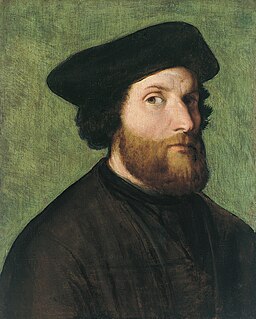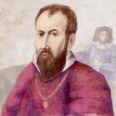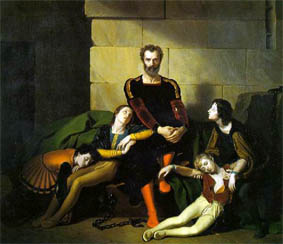
Girolamo Alibrandi (1470-1524), was an Italian painter, born and active in Sicily, called the Raphael of Messina (il Raffaello di Messina).

Girolamo Alibrandi (1470-1524), was an Italian painter, born and active in Sicily, called the Raphael of Messina (il Raffaello di Messina).
Alibrandi received his first instruction in the school of the Antonj. The fame which Antonello da Messina, his countryman, had acquired in Venice, induced him to visit that city. While there he received for a short time instruction from Antonello. He also enjoyed the friendship of Giorgione. Alibrandi afterwards went to Milan, where he became a disciple of Leonardo da Vinci. Alibrandi then went to Rome and studied the antique artifacts and the works of Raphael. From Rome he went to Parma, and thence back to Messina, where the town possesses his best works. [1]

His most important of work was a large picture of the Presentation in the Temple , painted in 1519 for the Chiesa della Candelora. [1] It was later transferred into the church of San Nicolò dei Gentiluomini, and then, following severe damage in the earthquake of 1908, to the collection of the Museo Civico in Messina, where it remains. [2] He also painted a Purification of the Virgin now in the Cathedral of Messina. [3] Alibrando died of the plague in 1524 at Messina. [1]

Fra Bartolomeo or Bartolommeo, also known as Bartolommeo di Pagholo, Bartolommeo di S. Marco, and his original nickname Baccio della Porta, was an Italian Renaissance painter of religious subjects. He spent all his career in Florence until his mid-forties, when he travelled to work in various cities, as far south as Rome. He trained with Cosimo Roselli and in the 1490s fell under the influence of Savonarola, which led him to become a Dominican friar in 1500, renouncing painting for several years. Typically his paintings are of static groups of figures in subjects such as the Virgin and Child with Saints.

Antonello da Messina, properly Antonello di Giovanni di Antonio, but also called Antonello degli Antoni and Anglicized as Anthony of Messina, was a Sicilian painter from Messina, active during the Early Italian Renaissance. His work shows strong influences from Early Netherlandish painting, although there is no documentary evidence that he ever travelled beyond Italy. Giorgio Vasari credited him with the introduction of oil painting into Italy. Unusually for a south Italian artist of the Renaissance, his work proved influential on painters in northern Italy, especially in Venice.

Lorenzo Lotto was an Italian painter, draughtsman, and illustrator, traditionally placed in the Venetian school, though much of his career was spent in other north Italian cities. He painted mainly altarpieces, religious subjects and portraits. He was active during the High Renaissance and the first half of the Mannerist period, but his work maintained a generally similar High Renaissance style throughout his career, although his nervous and eccentric posings and distortions represented a transitional stage to the Florentine and Roman Mannerists.

Polidoro Caldara, usually known as Polidoro da Caravaggio was an Italian painter of the Mannerist period, "arguably the most gifted and certainly the least conventional of Raphael's pupils", who was best known for his now-vanished paintings on the facades of Roman houses. He was unrelated to the later painter Michelangelo Merisi da Caravaggio, usually known just as Caravaggio, but both came from the town of Caravaggio.

Benvenuto Tisi was a Late-Renaissance-Mannerist Italian painter of the School of Ferrara. Garofalo's career began attached to the court of the Duke d'Este. His early works have been described as "idyllic", but they often conform to the elaborate conceits favored by the artistically refined Ferrarese court. His nickname, Garofalo, may derive from his habit of signing some works with a picture of a carnation.

Girolamo Francesco Maria Mazzola, also known as Francesco Mazzola or, more commonly, as Parmigianino, was an Italian Mannerist painter and printmaker active in Florence, Rome, Bologna, and his native city of Parma. His work is characterized by a "refined sensuality" and often elongation of forms and includes Vision of Saint Jerome (1527) and the iconic if somewhat anomalous Madonna with the Long Neck (1534), and he remains the best known artist of the first generation whose whole careers fall into the Mannerist period.

Melozzo da Forlì was an Italian Renaissance painter and architect. His fresco paintings are notable for the use of foreshortening. He was the most important member of the Forlì painting school.

St Jerome in His Study is a painting by the Italian Renaissance master Antonello da Messina. The painting depicts human, natural, and divine knowledge, and is filled with architectural qualities. It was the property of Antonio Pasqualino, Thomas Baring, 1st Earl of Northbrook, and has belonged since 1894 to the collection of the National Gallery, London.

The Virgin Annunciate is a painting by the Italian Renaissance artist Antonello da Messina, housed in the Palazzo Abatellis, Palermo, region of Sicily, Italy. Probably painted in Sicily in 1476, it shows Mary interrupted at her reading by the Angel of the Annunciation. It is painted in oil on panel, a technique introduced to Italy by its artist, who had learned it from North European artists such as Petrus Christus - by thus abandoning tempera technique he was able to produce the finely-detailed works typical of him.
The decade of the 1470s in art involved some significant events.

Antonio Barbalonga or Barbalunga, also called Antonio Alberti, was an Italian painter of the Baroque period.

Giuseppe Diotti was an Italian painter of the Neoclassic style.

Jean André was a French artist.

Andrea di Aloigi, called L'Ingegno, was an Italian Renaissance painter.
Vincenzo degli Azani was an Italian painter, active mainly in his native Palermo, except for a spell in Rome, where he came under the influence of Raphael. He is also known as Vincenzo da Pavia, Vincenzo Aniemolo, Vincenzo degli Azani da Pavia, Il Romano and Vincenzo Romano.
Alfonso Franco, was an Italian painter from Messina, Sicily, active during the Italian Renaissance.

The Museo Interdisciplinare Regionale (MuMe). or Regional Museum of Messina, is an art museum located on the northern coast of the city of Messina, Sicily, Italy.

The Interdisciplinary Regional Museum of Messina is a museum of painting, sculpture and archaeology in the city of Messina. Until 2017 it was housed in the former Barbera-Mellinghoff silk-mill, a late 19th century building chosen for it after the 1908 Messina earthquake. Since 2017 it has been housed in a nearby complex designed in the 1970s.

Letterio Subba was an Italian Romantic painter. He was born and died in Messina.

Michele Panebianco was an Italian painter. He was born and died in Messina.
Attribution: